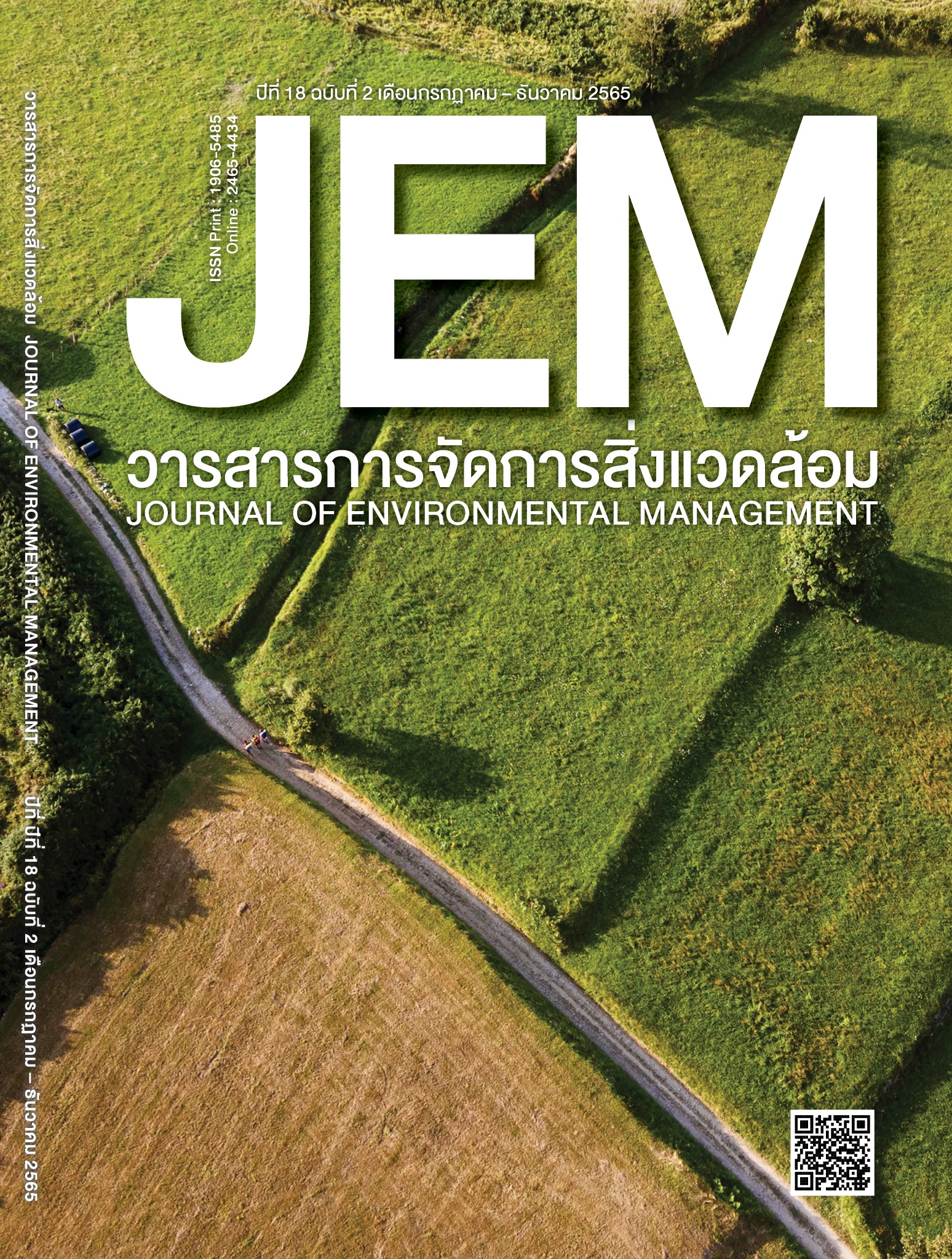การประมาณค่าความเข้มข้นของฝุ่นละอองด้วยข้อมูลดาวเทียมในภาคกลางของประเทศไทย
DOI:
https://doi.org/10.14456/jem.2022.8คำสำคัญ:
ความลึกเชิงแสงของละอองลอย (AOD), ฝุ่นละอองขนาดไม่เกิน 2.5 ไมครอน, ฝุ่นละอองขนาดไม่เกิน 10ไมครอน, MODIS, VIIRSบทคัดย่อ
การศึกษาครั้งนี้มีวัตถุประสงค์แรกเพื่อหาความสัมพันธ์ระหว่างข้อมูลฝุ่นละอองขนาดไม่เกิน 2.5 ไมครอน (PM2.5) และฝุ่นละอองขนาดไม่เกิน 10 ไมครอน (PM10) ซึ่งได้จากสถานีตรวจวัดของกรมควบคุมมลพิษ กับข้อมูล Aerosol Optical Depth (AOD) หรือ ความลึกเชิงแสงของละอองลอย จากดาวเทียม S-NPP เซ็นเซอร์ VIIRS และดาวเทียม Aqua เซ็นเซอร์ MODIS โดยใช้ข้อมูลรายวัน ตั้งแต่ มกราคม พ.ศ. 2556 - ธันวาคม พ.ศ. 2563 ผลจากการวิเคราะห์ความสัมพันธ์พบว่า ข้อมูล MODIS AOD และ VIIRS AOD มีความสัมพันธ์กับ PM2.5 และ PM10 ให้ค่าสัมประสิทธิ์สหสัมพันธ์ (R) ที่ใกล้เคียงกัน วัตถุประสงค์ต่อมาเป็นการสร้างแบบจำลองเพื่อประมาณค่า PM2.5 และ PM10 โดยใช้ข้อมูล VIIRS AOD ร่วมกับข้อมูลอุตุนิยมวิทยา ได้แก่ ความชื้นสัมพัทธ์ อุณหภูมิ และความเร็วลม โดยทำการวิเคราะห์การถดถอยพหุคูณ (MLR) และการถดถอยแบบถ่วงน้ำหนักภูมิศาสตร์ (GWR) พบว่า จากความสัมพันธ์ระหว่างค่า PM2.5 จากการประมาณกับ PM2.5 จากการตรวจวัดจริง ด้วยการถดถอยพหุคูณ และการถดถอยแบบถ่วงน้ำหนักภูมิศาสตร์ มีค่า R อยู่ในช่วง 0.40-0.70 และ 0.43-0.65 ตามลำดับ มีค่าความคลาดเคลื่อนเฉลี่ย (RMSE) อยู่ในช่วง 11.97-17.71 µg/m3 และ 11.83-15.80 µg/m3 ตามลำดับ และในส่วนของความสัมพันธ์ระหว่างค่า PM10 จากการประมาณกับ PM10 จากการตรวจวัดจริง ด้วยการถดถอยพหุคูณ และการถดถอยแบบถ่วงน้ำหนักภูมิศาสตร์ มีค่า R อยู่ในช่วง 0.56-0.76 และ 0.57-0.76 ตามลำดับ มีค่าความคลาดเคลื่อนเฉลี่ย (RMSE) อยู่ในช่วง 15.47-41.05 µg/m3 และ 16.26-38.85 µg/m3 ตามลำดับ
เอกสารอ้างอิง
Bao, V. Q., & Van, T. T. (2021). An empirical relationship between PM2.5 and aerosol optical depth from MODIS satellite images for spatial simulation over Ho Chi Minh city. Vietnam Journal of Science, Technology and Engineering, 63(4), 73-78.
Cao, C., Xiong, X., Blonski, S., Liu, Q., Uprety, S., Shao, X., & Weng, F. (2013). Suomi NPP VIIRS sensor data record verification, validation, and long-term performance monitoring. Journal of Geophysical Research: Atmospheres, 118(11), 11664-11678.
Charoenpanyanet, A., & Hemwan, P. (2019). Suitable Model for Estimation of PM2.5 Concentration Using Aerosol Optical Thickness (AOT) and Ground based Station: Under the Dome in Upper Northern, Thailand. International Journal of Geoinformatics, 15(3), 33-43.
Fotheringham, A., Brunsdon, C., & Charlton, M. (2002). Geographically Weighted Regression: The Analysis of Spatially Varying Relationships. John Wiley & Sons, 13.
Gupta, P., Christopher, S. A., Wang, J., Gehrig, R., Lee, Y., & Kumar, N. (2006). Satellite remote sensing of particulate matter and air quality assessment over global cities. Atmospheric Environment, 40(30), 5880-5892.
Han, S., Kundhikanjana, W., Towashiraporn, P., & Stratoulias, D. (2022). Interpolation-Based Fusion of Sentinel-5P, SRTM, and Regulatory-Grade Ground Stations Data for Producing Spatially Continuous Maps of PM2.5 Concentrations Nationwide over Thailand. Atmosphere, 13(2), 161.
Handschuh, J., Erbertseder, T., Schaap, M., & Baier, F. (2022). Estimating PM2.5 surface concentrations from AOD: A combination of SLSTR and MODIS. Remote Sensing Applications: Society and Environment, 26.
Levy, R. C., Munchak, L. A., Mattoo, S., Patadia, F., Remer, L. A., & Holz, R. E. (2015). Towards a long-term global aerosol optical depth record: applying a consistent aerosol retrieval algorithm to MODIS and VIIRS-observed reflectance. Atmospheric Measurement Techniques, 8(10), 4083-4110.
Liu, M., Huang, Y., Ma, Z., Jin, Z., Liu, X., Wang, H., . . . Kinney, P. L. (2017). Spatial and temporal trends in the mortality burden of air pollution in China: 2004–2012. Environment International, 98, 75-81.
Mei, L., Zhao, C., de Leeuw, G., Burrows, J. P., Rozanov, V., Che, H., & Zhang, X. (2019). A Critical Evaluation of Deep Blue Algorithm Derived AVHRR Aerosol Product Over China. Journal of Geophysical Research: Atmospheres, 124(22), 12173-12193.
Meteorological Department of Thailand, (2013). Climate in Thailand [In Thai]. Retrieved January 14, 2022, from https://www.tmd.go.th/info/knowledge_weather01_n.html .
Mongkolphew, S. (2019). Assessment of the Relationship of Particulate Matter between Satellite and Ground based Measurements in Thailand [In Thai]. Unpublished Master’s thesis, Kasetsart University.
Muhammad, Z., & Nguyen Thi, K. O. (2015). Relationship of MISR component AODs with black carbon and other ground monitored particulate matter composition. Atmospheric Pollution Research, 6(1), 62-69.
National Aeronautics and Space Administration. (2021). Instrument Differences MODIS and VIIRS Instruments. Retrieved January 14, 2022, from https://darktarget.gsfc.nasa.gov/instrument-differences.
Piyapimonsit, C. (2016). Using IBM SPSS Statistics for Data Analysis [In Thai]. Bangkok: Kasetsart University.
Pollution Control Department. (2020). Thailand State of Report 2020 [In Thai]. Pollution Control Department, Bangkok.
Popp, T., De Leeuw, G., Bingen, C., Brühl, C., Capelle, V., Chedin, A., & Xue, Y. (2016). Development, Production and Evaluation of Aerosol Climate Data Records from European Satellite Observations. Remote Sensing, 8(5), 421.
Sawyer, V., Levy, R. C., Mattoo, S., Cureton, G., Shi, Y., & Remer, L. A. (2020). Continuing the MODIS Dark Target Aerosol Time Series with VIIRS. Remote Sensing, 12(2), 308.
Tsai, T.-C., Jeng, Y.-J., Chu, D. A., Chen, J.-P., & Chang, S.-C. (2011). Analysis of the relationship between MODIS aerosol optical depth and particulate matter from 2006 to 2008. Atmospheric Environment, 45(27), 4777-4788.
Wang, Y., Yuan, Q., Shen, H., Zheng, L., & Zhang, L. (2020). Investigating multiple aerosol optical depth products from MODIS and VIIRS over Asia: Evaluation, comparison, and merging. Atmospheric Environment, 230, 117548.
Wei, J., Li, Z., Sun, L., Yang, Y., Zhao, C., & Cai, Z. (2019). Enhanced Aerosol Estimations From Suomi-NPP VIIRS Images Over Heterogeneous Surfaces. IEEE Transactions on Geoscience and Remote Sensing, 57(12), 9534- 9543.
World Health Organization. (2021). WHO global air quality guidelines: particulate matter (PM2.5 and PM10), ozone, nitrogen dioxide, sulfur dioxide and carbon monoxide. World Health Organization.
Xiao, Q., Zhang, H., Choi, M., Li, S., Kondragunta, S., Kim, J., & Liu, Y. (2016). Evaluation of VIIRS, GOCI, and MODIS Collection 6 AOD retrievals against ground sunphotometer observations over East Asia. Atmospheric Chemistry and Physics, 16(3), 1255-1269.
Xiong, J. & Butler, J. (2018). MODIS and VIIRS Instrument Status. In Proceedings of the MODIS–VIIRS Science Team Meeting. NASA.
Yao, F., Si, M., Li, W., & Wu, J. (2018). A multidimensional comparison between MODIS and VIIRS AOD in estimating ground-level PM2.5 concentrations over a heavily polluted region in China. Science of The Total Environment, 618, 819-828.
Zeeshan, M., & Kim Oanh, N. T. (2014). Assessment of the relationship between satellite AOD and ground PM10 measurement data considering synoptic meteorological patterns and Lidar data. Science of The Total Environment, 473-474, 609-618



